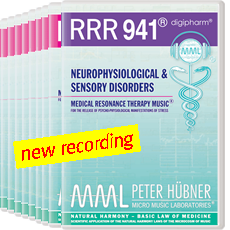|
| SCIENTIFICALLY INTRODUCING UNIVERSALITY TO THE UNIVERSITY |
|
| peter huebner • micro music laboratories |
| M E D I C A L R E S O N A N C E T H E R A P Y M U S I C® |
| R E D U C T I O N O F P S Y C H O – P H Y S I O L O G I C A L M A N I F E S T A T I O N S O F S T R E S S |
Scientific Studies and Clinical Observations
| CEREBRAL & NERVOUS SYSTEM |
- Improvement in the individual profile of the functional asymmetry of the brain in women on whom a vacuum aspiration had been carried out: in 55.5% of the patients there was a positive pattern of change, in 11.1% a negative pattern of change and in 33.4% no appreciable change was determined. The values in the control group were: in 36.4% there was a positive pattern of change, in 53.5% a negative pattern of change and 11.1% remained without appreciable change
- Reduction of betawaves in patients with multiple sclerosis
- Improvement of the neurotransmission speed of the optic nerve in multiple sclerosis patients: at a peak by 27 milliseconds
- Increased ability to learn in older people and people of middle-age with atherosclerotic encephalopathy: after 10 treatment sessions the ability to learn had improved by an average of 18%
- Improved reaction precision in older people and people of middle-age with atherosclerotic encephalopathy: after 10 treatment sessions the precision of reactions had improved by an average of 18%
- Increased psychomotoric speed in older people and people of middle-age with atherosclerotic encephalopathy: after 10 treatment sessions the psychomotoric speed had improved by an average of 9.6%
- Improved reaction speed in older people and people of middle-age with atherosclerotic encephalopathy: after 10 treatment sessions the reaction speed had improved by an average of 18%
- Normalization of high blood pressure occasioned by neural dysfunction in children with a hypertonic type of neurocirculatory dystonia: normalization of the systolic and diastolic vascular pressure, of the average vascular pressure and of the arterial pressure, normalization of the heart rate and breathing
If you want to look at the studies in detail, please visit:
